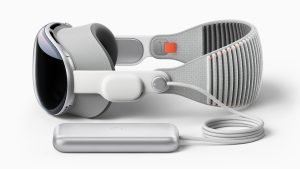At launch, the Apple Vision Pro certainly made a lot of noise. It was seen both as the perfect example of the future of computing, and prime meme material. Apple fanboys caught wearing it in the wild were mercilessly mocked online, while tech journalists heralded it as magic. Now, over six months later, it appears some of that magic is wearing off. With the device available for sale for over six months, it appears Tim Cook & co might not have the winner on their hands they thought they did.
In terms of sales, the news is far from good for Apple. Within the first 10 days, the company reportedly sold 200,000 devices including preorders. It was reported that the company targeted 800,000 units in 2024, but sales have tanked so much that the company has now slashed its target to 450,000. Keeping with that new goal in mind, it is reported the company has slashed production volumes of the Vision Pro. In fact, things have been so poor that noted analyst Ming-Chi Kuo noted that the company might even be considering shelving a planned update in 2025.

Amidst this gloomy outlook, there are rumors that Apple could expand sales of the Apple Vision Pro to other geographies. Notably, the UK could be on the list of countries due to get the device, with The Independent’s Andrew Griffin noting that the May 2024 “Let Loose” event will be followed by a smaller event in London. Griffin believes the event will give UK journalists a chance to play with the Apple Vision Pro ahead of its launch in the country. At the time of launch, Apple said the device would come to more countries “later this year”, so Griffin’s reporting does seem to make sense. The question remains though – do global consumers have an appetite for spatial computing?
A Hard Sale
Selling an entirely new product category isn’t easy, even for Apple. While AR/VR headsets have been around for a while now, they have largely been niche products in two areas – gaming-centered headsets like the PSVR and Occuus, or more discreet smart glasses like the Meta RayBans. No tech company has tried to make AR/VR “the future of computing” after the very public collapse of the metaverse. Meta’s vision was not unlike Apple’s, but truly terrible software and poor hardware made it difficult to believe that the future would have us all strapped with headsets working from home.
To its credit, Apple did manage to outdo Meta on both the hardware and software front. Early reviews almost universally praised Apple’s input system and visionOS, clearly indicating that if done right, there was a future for this kind of device at work and in our lives. However, at $3,499, the Apple Vision Pro is far from affordable. Not only is it one of Apple’s most expensive devices, it is one of the most expensive AR/VR headsets out there. For comparison, the Meta Quest 3 is $500, and the PSVR is $550. There is no headset anywhere near Apple’s price range, making it a hard sell for any consumers even interested in the technology.
Then of course there is the technology itself. AR/VR has been around for a while now, but it is yet to find its way into general use. Barring gaming, there are too few industries that have widely adopted AR/VR into their daily routine. Apart from really niche use cases like remote surgery, or industrial design, most jobs and industries seem to get by just fine without needing to strap on a headset. This is also a function of the fact that headsets tend to isolate users from their environment, something Apple tried to resolve through its ‘EyeSight’ feature that hasn’t been as revolutionary as the marketing suggests. In short, the world simply isn’t ready for AR/VR headsets in our daily lives, which is why early Apple Vision Pro adopters were trolled as brutally as they were.

Apple Vision Pro Goes Global
Knowing these facts, its hard to see why Apple would consider rolling out the Vision Pro globally. It’s very unlikely the company will find sympathy or eager buyers outside its home turf, especially at a time when it is coming under immense scrutiny from multiple governments. Even with the slashed orders, it seems unlikely Apple will magically sell all the units of the Apple Vision Pro it makes, even if the expansion includes multiple countries. However, now that it has committed to the device, a global expansion might just be what Apple needs to reinvigorate interest in the device. According to job listings, the company is looking to expand the Apple Vision Pro to China, Japan, Canada, Australia, and the UK. There is no exact timeframe, but it could very well be the case that the global rollout comes on the heels of the company’s May event, or WWDC 24. Going global after WWDC would make the most sense, as whatever updates Apple makes to visionOS might help drum up interest in the device.
However, software alone isn’t going to sell units. For the Vision Pro to really attract consumers, Apple will need to address its price point. That however seems very unlikely. Multiple executives including CEO Tim Cook have defended the eye-watering price, calling the Vision Pro “technology of the future”. That may indeed be the case, but without addressing the price, it appears Apple is shooting for a future the present simply isn’t ready for. This begs the question – where does the Vision Pro go from here?
The Future
Perhaps interestingly, Apple’s first-generation spatial computing headset was given the “Pro” moniker, indicating that at some point the company will launch a cheaper version of the device. That would make the Apple Vision Pro more accessible to consumers, albeit at the cost of some features. It’s unclear if a cheaper Vision Pro is in the works for 2025 or later, but whenever it does come, it will be very interesting to see what features Apple is happy to drop. Some like Eye Sight are most certainly likely to get the axe, bringing the device more in line with the Quest or PSVR.
However, price alone won’t help the Vision Pro. The product category itself has two fundamental issues – one is a genuine use case, and the other is its ability to isolate users. The former can easily be resolved through hardware and software. Apple could simply consider gaming to be the best use case for the Vision Pro, like healthcare became the standard use case for the Apple Watch. Any and all other use cases could simply be seen as a bonus. However, Apple clearly does not want to go down that path. It has gone well out of its way to present the Vision Pro as a device for work and daily life. It is a big challenge to overcome for sure, one that requires robust participation from the developer community.

That is however nowhere as big as Apple’s second challenge. Right now, headsets haven’t found a way to seamlessly integrate into daily life. Unlike smart glasses, they are bulky and block the eyes, a key component in human interaction. Even if Apple does improve on EyeSight, it is just not going to be the same. There’s always going to be a stigma with headsets, one that our collective consciousness won’t overcome so easily. It may change, in the future with more people wearing them in public. To achieve that, a global rollout of the Vision Pro is the only way forward.






